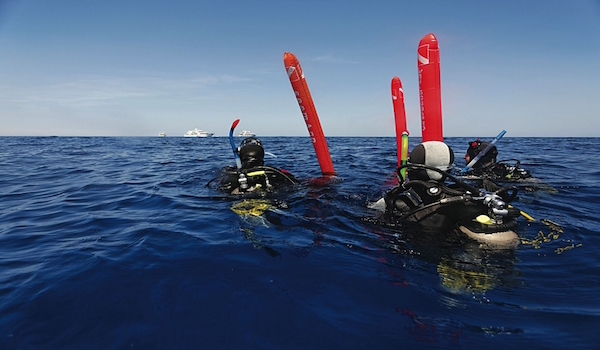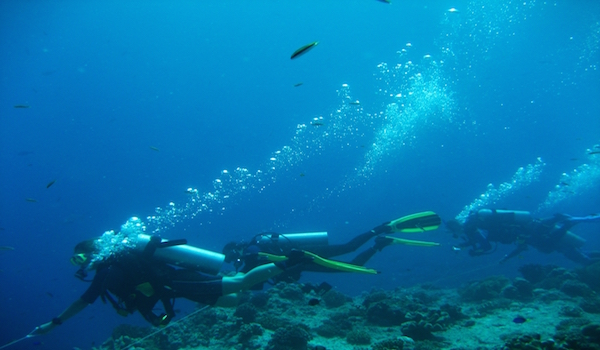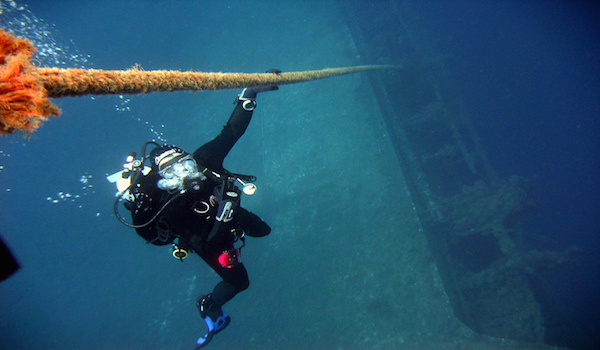How To Dive in Strong Currents And Not Get Swept Away?
A dive in strong currents can be fun and exciting but can be deadly too if you are not prepared or trained.
A current can change a nice relaxing dive into a strenuous workout in a matter of seconds. Like anything else in scuba diving, or life for that matter, preparation can turn an uncertain event into a positive memory.

When You Dive in Strong Currents You Need to Have a SMB. Photo Credit: The Real Maldives.
When we are talking about diving in strong currents, there are generally three different types of dives we can use depending on the dive site and currents.
Drift diving
Many of the most exciting dives in the world are drift dives. As the name implies, the diver just drifts with the current. Normally, the current and diver is following the face of a wall. Coral and the marine life along the wall will likely be feeding on the nutrients the current brings with it.
Pelagic species will often be with you doing the same thing you are doing, drifting with the current, except they see the wall as a buffet table.
While drift diving, the dive boat will follow you from the surface.
It is important that the group stays close together and often critical that dive teams do not become separated from each other. In some situations, a tether line connecting dive buddies may be used
Also read: 5 Must Do Awesome Drift Dives You Should Dive When In Cozumel
Your next dive
You may arrive at your next dive site to find that it has a current at the time. The current is just an additional factor in the dive planning. Each of these activities will have different methods that have to be applied as you dive.
Reef Hook diving
A reef hook is a small little-blunted hook that is used to latch on to a rock. Attached to the hook is a meter and a half to two meters long, strong line that is attached by a D-ring to your BCD.
Once you have attached yourself to a rock, you adjust your buoyancy to be slightly above the reef and then watch the surrounding action. On some dive sites, you may be hooking yourself into a crevice on a wall instead of above the surface of the reef.

Reefhookdive in strong current. Photo Credit: tobze
The following 5 tips might not apply in each of the diving situations previously mentioned, but they do provide a good starting point to prepare yourself for a current dive.
1. Be mentally and physically prepared for the current before entering the water
Diving in a current is something that you just cannot learn by reading about. It is something you have to experience to understand. Few people have a good concept of current speed and how it will affect you and your dive.Currents are measured in knots and are based on the nautical mile per hour.
A nautical mile is equal to 1.15 miles. The average person walks at about 3 miles per hour or about 2.6 knots.Many diver propulsion vehicles (DPV) designed for recreational divers also have a similar top speed. If you have every seen a diver racing by on a DPV, then you can visualize what it a 2.5-knot current can do.
A 0.5-knot current is considered mild. However, the time it takes you to take your hand from the down guideline to your mask and back to the guideline is long enough for the current to move you out of reach of the line.
Also read: 6 Reasons Why Scuba Divers Are Fitter Than You are
A 1 knot current at the surface can make your in water preparation difficult. Dive boats will often set out drift lines to help you get to the down line. Waiting for the group to get together means holding on to a rope and being battered by the waves. Your body will be forced into a horizontal position.
Stronger surface currents might require a negatively buoyant entry. In this type of entry, dive teams enter together with little or no air in their BCD and immediately continue their descent. This is a skill best practiced under calm conditions.
2. Adjust the dive briefing for the conditions
The current observed upon arriving at the dive site might require that the dive plan be changed. Anything stronger than a mild current will drastically cut your dive time if you are exploring a dive site.
It may also make your return to the boat more difficult, and you might want to consider increasing your reserve. When on site; plan you dive and dive your plan.
3. Swim against the current
The first part of your dive should be against the current. Except for drift dives, your dive should be planned and conducted so that you return to the line that brought you down.
Swimming against the current will cause you to use greater physical effort and will more rapidly consume your air supply. However, returning to your starting point will require less effort and give your muscles a little time to rest before starting your ascent.
Staying close to the bottom will reduce the effect of the current and if necessary allows you to use your reef hook or to grab a rock (NOT CORAL) to hold yourself in place to have a short rest.
Often features such as a wreck or reef ridge may provide protection from the effect of the currents. Keeping your body and equipment as streamlined as possible and allowing only the smallest possible body profile exposure to the current will minimize the effect as much as possible.
Also read: 4 tips On What to Do If You’re Left Behind in Open Water
4. Practice situational awareness and use the rule of thirds.
Being aware of your surrounding underwater is always important. However, it can save your life in a current situation.
A key point to never forget about currents it that they are not constant. As you descend, the speed and the direction of the current will change.
While you may think you are swimming directly into a current, you may, in fact, be swimming off by a slight angle. Therefore, when you turn around and let the current guide you back to your line, you are not retracing your route. Also, while swimming in the current, its direction may have changed.
Divers trained in overhead environments are well known to use the rule of thirds. This principal says to plan your dive to use 1/3 of your air into the environment and to save 1/3 for your exit. This leaves you a little extra in case you are delayed exiting the environment. You should also consider this principal in strong currents.
Leave yourself a buffer, in case you get down current from your exit point and need to swim against the current to return to it. Trying to ascent down current of your guideline and angling up to meet it, is very difficult and may be impossible.
5. Safety stops and returning to the boat.
Returning to the boat using the anchor line or another guideline follows the same routine as any other dive. You slowly ascend and take any mandatory and precautionary safety stops that are called for.
You should note that you will likely need to stay in contact with the line to keep from being drifted off. Additionally, the line may be subject to more motion than you are used to making it difficult to maintain a precise depth.

When ascending in a current stay close to the line and dont let go. Photo Credit: utnapistim
If you miss the line and must make a free ascent, activate your DSMB as soon as you can. This will give additional time for the surface crew to see the marker and understand that you are drifting. If they have a small boat they can launch, it is possible that they can follow you if not at least they can track you.
Remember, they have other divers in the water. They cannot pull up anchor and chase you down.
Every day all over the world the coast guard is called to retrieve divers drifting because the dive boat was not able to leave its position to get them.
Diving with currents is an exciting aspect of scuba diving and one that opens the diver to experiences not often found in calm waters. Try a few mild current dives and start expanding your diving skills.
Do you like diving in currents? Let us know in the comments below
Feel free to contact us. We have multiple partners that offer dive packages + accommodation and scuba lessons.
This article is published by The Scuba Page, the online magazine for Scuba Dive lovers around the world. The Scuba Page is part of RUSHKULT: the online booking platform for adventure sports. Visit the RUSHKULT platform to book your next Scuba Dive training, guided trip and accommodation.

Leave a Comment